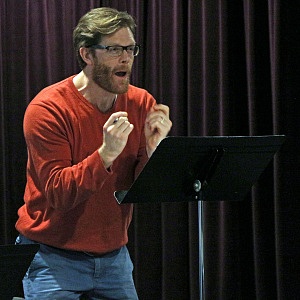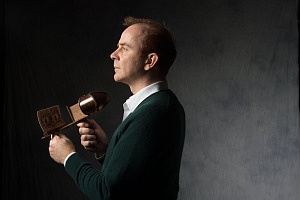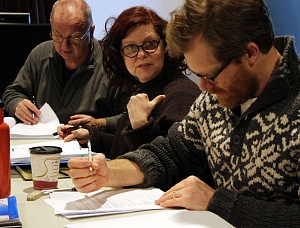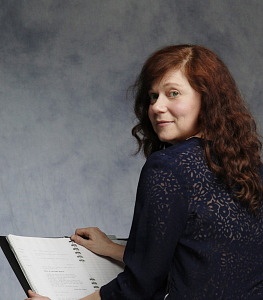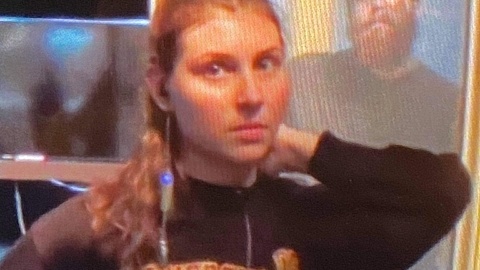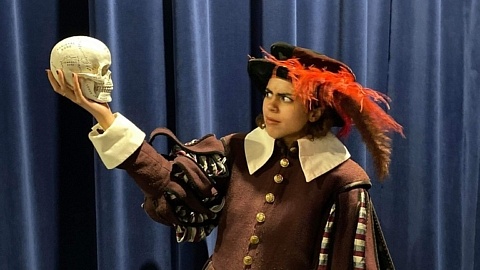It’s been a few weeks since the final performance of Brock University Department of Dramatic Arts’ Fall Mainstage, Scenes from an Execution. Closing off their...
“Major Barbara” gets a Major Update: Developing Shaw for the Digital Age
By DART Critics
February 22, 2016
Nikka Collison, DJ Johnston, Justin Reesor and Jarrod Vandenbogaerde write: Never underestimate the power of footwork. The beginning of the week of Major Predictions, Barbara workshops was all about table work, and that makes sense given the nature of this project – a staged reading. Much of the work of the director and actors was about the meaning of the text and about vocalization. When we came in to observe the final day of the workshop on Saturday, February 20, all we knew was that the company were running through the show.

From left: Sean McClelland (Barbara), Michelle Mohammed (Sarah), Adrian Marchesano (Charles), Martin Happer (Cusins), Colin Anthes (Stephen), and Ric Reid (Undershaft). Lezlie Wade (director) in foreground.
To paint the picture: in the previous sessions we attended the company were all sitting at a table in the centre of the studio. Now the table had been moved to the side for Lezlie (director), David (playwright), Karen (producer), and we embedders to sit at, while the actors took the stage. The stage consists of a music stand and chair for each actor, with sets of chairs on either side to create an offstage (but still visible) space. The stage manager, Kendra, was sitting at a tech console. Our first impression was that it was cool to see the actors were finally standing – but being that it also a dramatic reading, we were not expecting what happened next.
When they started running through the show, the characters were alive. They were using props like a tablet and headsets to show transitions between reality and the virtual world. With the use of these props everything started to make a lot of sense. During the table read we found it challenging to understand where the characters were at any given point and had to lean on the stage directions that Lezlie read before each scene. Now, though Lezlie still reads some of the stage directions, they are not as needed to be able to follow what is going on. By the end of watching the second act we knew this wasn’t the same show anymore.
In just two days, the ensemble has this piece on its feet. The characters are responding to one another – their posture, facial expressions, and just energy as a whole filled the rehearsal space and it was truly spectacular. When switching gears to doing one last read-through before the day of the performance, we got a chance to listen to the sound effects. From the 8-bit, ’80s style video game music which opens the show, to the simple buzzing of a cell phone signalling an incoming message, the sound really helps illustrate what is happening. This reading did not extend to costumes, however, so we are only left to imagine the high-level battle armour in Cusins’ video game (which – for those of you who will get this reference – can only be described as what you’d earn by playing Skyrim and beating it three times over).
Throughout the three hours we were in the room, the actors were fully engaged with the work, and in the breaks the cast and crew talked and joked with one another as if they were long-time friends. Martin Happer’s performance as Cusins brings together the seductive and narcissistic aspects of his character. It was just an absolute joy to soak in every single line of his performance. Sean McClelland, who plays Barbara, is bringing a great deal of expressiveness and openness to her performance. The laughter in some scenes feels a lot more natural than it did earlier in the week.
From the beginning of this embedding we knew that the result was not going to be a production but rather a reading. However, when leaving the space after that rehearsal, it was hard to distinguish the difference. Sure, there isn’t a lot of movement, and the actors are reading from behind music stands – but this talented ensemble have brought this play to life through voice work and characterization. Major Predictions, Barbara is going to have sound effects, it’s going to have lights; the line between “production” and “dramatic reading” is very thin.
The cast will meet again Tuesday afternoon at 4pm to do one final read-through before performing in Studio A at the Marilyn I. Walker School of Fine and Performing Arts at 7:30pm.
February 17, 2016
Nikka Collison, DJ Johnston, Justin Reesor and Jared Vandenbogaerde write: Major Predictions, Barbara marches to the beat of its own drum, and it’s fantastic! The workshop now underway in Studio A at the Marilyn I. Walker School of Fine and Performing Arts is full of creativity and surprises. On February 16 the cast and production team met for the first time to read David Fancy’s script, which is inspired by George Bernard Shaw’s original play Major Barbara; we, as embedded critics following the production behind the scenes, were present for half of that first session and returned the next morning to watch the group work further.
The cast includes distinguished actors Martin Happer (Cusins), Nora McLellan (Britomart), and Ric Reid (Undershaft) — all of whom have considerable experience in the Shaw Festival ensemble; Colin Bruce Anthes (Stephen) — who graduated from our department several years ago; and current Brock Dramatic Arts students Sean McClelland (Barbara), Adrian Marchesano (Charles), and Michelle Mohammed (Sarah). Also in the room on the first day of the workshop were the director Lezlie Wade; Fancy, the writer; stage manager Kendra Neaves; Karen Fricker, the producer; and dramaturg Graeme Somerville.
Graeme has acted for the past 14 seasons at the Shaw Festival, and teaches about the theatre of Shaw’s era at the Festival and the National Theatre School. He came to the rehearsal to share his knowledge about Major Barbara. “Shaw relies on social convention and turns it inside out,” Graeme explained; this is how Shaw finds the comedy in his material – the comedy which, as Brecht said, “is his bombs.”
With his adaption, David Fancy brings the ideas in Shaw’s play into our era. He calls this “using pieces of texts to create something new.” Major Predictions, Barbara echoes the themes of Shaw’s original in its comparison of actual warfare to digital warfare, and the original is also present in that portions of Shaw’s script are interspersed in the new play. David’s script is set in the world of video gaming: Cusins is a computer programmer who is pursuing a government contract for his software — a strategy calculator that can predict an enemy’s next move. Barbara is a surveillance genius and government-sanctioned hacker who wants to make sure that everything that Cusins does is morally right (as she sees it) for the gaming world. A major aspect that the audience should be aware of is that the play moves between virtual and real worlds, and it is Cusins who controls these moves. From a theatrical point of view he is the ringmaster. Making this back-and-forth clear for the audience is a big focus of Lezlie’s attention; the actors are going to wear masks to indicate the changes and Lezlie herself will read the stage directions aloud.

David Fancy, Colin Anthes, Sean McClelland, Adrian Marchesano, Michelle Mohammed, and Nora McLellan. Photo by David Vivian.
The cast and creative team had a really great start in making the environment relaxed and comfortable for everyone to share their ideas. Cracking jokes and making connections with the script have started to bring this team together to create something remarkable! As they started to read through the complex script and interpret it, David said, “I don’t want my view to be the only view.” Lezlie asked specific questions of the actors about what might be going on with their characters at particular points and after that actor spoke others offered their input as well.
David is proving to be more than open to alterations including line changes, the addition of new props, and at one point even cutting an entire scene! This happened when, after some deliberation, the group agreed that a two-page scene almost entirely made up of Shaw’s original text slowed down the flow between the scenes before and after it and so decided it had to go. As theatre students, we looked at each other in shock when we saw a playwright so willingly make such a sacrifice for the good of the piece.
While Lezlie is taking this reading seriously as a production in its own right (albeit one that won’t involve any blocking other than the actors standing up and sitting down) she also made frequent references to how she would stage it as a full production. This becomes crucial information that the actors may use to add to their character development. She helps the actors understand who they are and what they want by asking questions such as “What are the stakes for your character” and “What intention would they have?”
The whole experience contained more energy than we expected from just a reading of a script. On the first day the actors seemed particularly “into it,” determined to prove what was interesting about their characters. On the second day, it was more like getting down to the nitty-gritty of the script’s meaning. In our observation the professional actors have a better idea about how they want their characters to behave and what their mannerisms are, whereas the student actors are working to match that level of intensity (and, to their credit, are holding their own and keeping pace.)
It was a more critical and intellectually engaged table read than any other we’ve been involved in. One point leads to another and the conversation goes in unexpected directions: a question about what the word “cuisses” means prompted another about why Cusins elaborately describes his physical appearance in a virtual world, which led to a conversation about narcissism in the gaming community – the extent that gamers will go to show off or flaunt themselves even if it means risking their virtual life for it.
Overall, Major Predictions, Barbara touches on many different and fascinating areas of subject matter, from the virtual reality/reality relationship, to the Oedipal struggle of parent and child, to how much control actually means to people!
The show itself goes up February 23, 2016 in Studio A at the Marilyn I. Walker School of Fine and Performing Arts, and we will file our next report after this Saturday’s rehearsal.
February 8, 2016
Nikka Collison, DJ Johnston, Justin Reesor and Jared Vandenbogaerde write: For our embedded criticism project the four of us are following Major Predictions, Barbara, a new play by David Fancy inspired by George Bernard Shaw’s Major Barbara. Throughout the process of this workshop and public reading we’re going to create blog posts like this one to keep you, our readers, updated on the happenings behind the scenes.
This project is part of the Imagining the City season which celebrates the opening of the Marilyn I. Walker School of Fine and Performing Arts in downtown St. Catharines. The three departments and one centre at the school (Dramatic Arts, Music, Visual Arts, and Studies in Arts and Culture) have curated a series of events themed around the relationship of art and creativity to the broader urban and regional environment. This project’s jumping-off point makes reference to the important place of Shaw’s plays in the Niagara region thanks to the presence of the Shaw Festival here. The Major Predictions, Barbara project brings together locally-based professionals who have a relationship to the Shaw Festival with DART students and recent graduates.
On the 20th of January, our group got the opportunity to interview Fancy, the playwright (who is also a faculty member in our department); director Lezlie Wade; and stage manager Kendra Neaves. Karen Fricker was also in attendance, who is not only the professor of our theatre criticism class, but also happens to be the producer of the show.
Before we tell you about Fancy’s new play, a reminder about the content of Shaw’s original seems in order. Major Barbara explores themes of war, money, class and gender through the story of a family and their soon-to-be-spouses. The play mainly focuses on Barbara, who is a major in the Salvation Army; her father Undershaft who is a major military industralist; and her fiancé Cusins. Through the play Shaw asks hard questions about what counts as virtuous and what counts as selfish and greedy in a capitalist system which depends on war to function.
David Fancy’s play brings home that in today’s society, the power of money, and the fear and power of war are still very relevant themes. His story makes Cusins and Barbara the focus. Cusins is a video game developer who has made software that can predict what an opponent’s next move will be. Clearly, this would be something of real-world interest to governments, as they would be able to know exactly what the enemy would do in a warfare situation. Barbara is a government agent who becomes interested in Cusins’ work and wants to bring him on side. Cusins lures her into a virtual reality experience to show her the power of what his program can do. The play goes back and forth between Fancy’s text, and text from Shaw’s original.
When we got the chance to interview Fancy, Wade, and Neaves of course the first question we asked was — why this play? Fancy’s answers were very to the point. Canada is a country at war; the themes of Major Barbara are still quite relevant to our times. He chose the videogame aspect to connect to the idea of digital warfare, which is central to how war is conducted in our times. Fancy also underlines that he wanted to maintain Shaw’s focus on class and gender. He underlines in this videogame world, Barbara isn’t a Lara Croft (who, for those who might not know, is a tough but highly sexualized video game character); Barbara is a complex character in a complex situation.
We were all also curious about how he went about writing the play. “Notepads everywhere!” exclaimed Fancy. His pattern in terms of creative process seems to be: read the source text, write down a lot of ideas (on the aforementioned notepads), take a break, and then purge the unimportant stuff. He said it was difficult to decide what was the most relevant and useful material from Shaw’s play. At the time we spoke he was working on a new draft which he says is “moderately” different to the one we were reading; we are excited for the workshop week when we can see how the play has grown and changed!
We wanted to hear how this reading was going to be staged, so we asked Wade what she’s envisioning. She mentioned a very important piece which is that the stage directions will be spoken to help the viewers picture the action. She talked about the importance of the actors getting to know the text well so they can still deliver the character even with absence of movement (a key reason why the play will be read and not staged is because some of the performers are on Actors’ Equity contracts which do not allow for physical staging). Masks may be used to help communicate transitions between the contemporary and classic texts and from the real to the virtual world. Fancy underlined at this point that a lot the his work on the new draft was to make those transitions clearer and more apparent. A big challenge for the actors and director in the reading is going to be how to deliver the text without the use of movement and minimal technical effects such as lighting or sound.
Finally, the endgame. Where is the show going to go after this? To our surprise, the answer was there wasn’t one — or rather, that the reading itself is the point of the exercise. Due to how much time and money have to be put in to staging a production, Fancy does not intend to take this play further after the reading, though he says he may post it on line for others to read. Perhaps this will allow someone else to pick up the script and see what they can do with it.
The most exciting news for our group is that Wade loves the idea of having us following the process, and plans to confer with us when she can during the workshop. This will be great because being silent flies-on-the-wall really isn’t one of our strengths as a collective — we are theatre students, after all! Our active embedding work begins during the workshop week of February 15th. Though we still have a few weeks to go, we’re getting excited for more behind the scene looks at Major Predictions, Barbara — and hope that you are too!
Related Posts
Here’s Holly Hebert’s final solo vlog from behind the scenes of the Fall 2020 DART Mainstage, Scenes from an Execution. She and Asenia will round off this...
Scenes from an Execution has opened, and even as someone working on it I was floored by how well the ambitious design turned out and how far the actors have...
Here’s Holly Hebert’s final solo vlog from behind the scenes of the Fall 2020 DART Mainstage, Scenes from an Execution. She and Asenia will round off this...
Scenes from an Execution has opened, and even as someone working on it I was floored by how well the ambitious design turned out and how far the actors have...
Leave a Reply (Cancel Reply)
Twitter Feed
Blogroll
DARTcritics.com is partially funded by the Marilyn I. Walker School of Fine and Performing Arts, in support of student learning; experiential education; student professionalization; public engagement with the teaching, learning and production activities of the Department of Dramatic Arts; new ways of thinking; and the nurturing of links with our communities.


